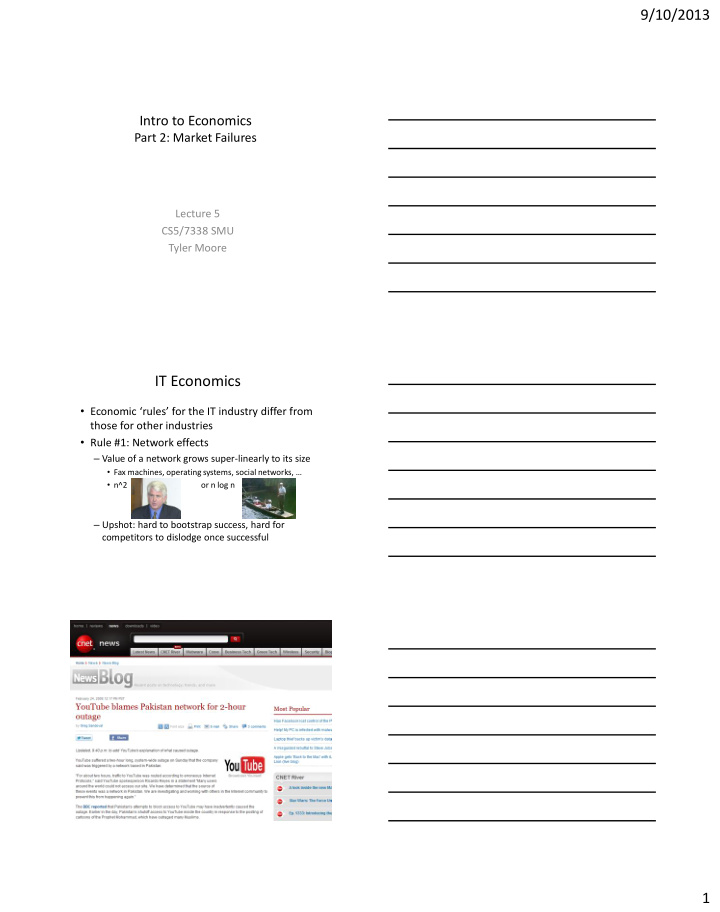



9/10/2013 Intro to Economics Part 2: Market Failures Lecture 5 CS5/7338 SMU Tyler Moore IT Economics • Economic ‘rules’ for the IT industry differ from those for other industries • Rule #1: Network effects – Value of a network grows super-linearly to its size • Fax machines, operating systems, social networks, … • n^2 or n log n – Upshot: hard to bootstrap success, hard for competitors to dislodge once successful 1
9/10/2013 Network effects and infosec • Many technical security solutions become effective only when many people adopt them – Introduced in 1996, S-BGP authenticates the paths routers advertise and could have prevented Pakistan telecom from shutting down YouTube – However, S-BGP is only valuable if all ISPs switch – Why is email still sent unauthenticated? • Security protocols which have succeeded offer immediate value to adopting firms (e.g., SSH) IT Rule #2: High fixed costs and low marginal costs of production Traditional industry: high fixed IT industry: high fixed & low marginal costs & high marginal costs CC licence: Flickr user Richard Bao CC licence: Flickr user CanadaGood Competition drives price down to marginal costs of production (i.e., $0!) IT Rule #3: Switching costs determine value • Switching from one IT product or service is usually expensive • Shapiro-Varian theorem – net present value of a software company is the total switching costs – Once you have $1000 worth of songs on iTunes, you’re locked into Apple’s ecosystem – Why can Microsoft still charge for Office despite ‘free’ alternatives? • Beware security mechanisms used to promote lock-in (e.g., digital rights management) 2
9/10/2013 IT Economics and Security • The high fixed/low marginal costs, network effects & switching costs in information industries all tend to lead to dominant-firm markets with big first-mover advantage • So time-to-market is critical • Microsoft philosophy of ‘we’ll ship it Tuesday and get it right by version 3’ is not perverse behavior by Bill Gates but quite rational • Whichever company had won in the PC OS business would have done the same IT and public goods • Most goods can be privately consumed (e.g., cars, food) • But somethings can’t be privately consumed (e.g., national defense, grazing commons) • Public goods have two characteristics that make them hard to allocate efficiently – Non-rivalrous: individual consumption does not reduce what’s available to others – Non-excludable: no practical way to exclude people from consuming • Public goods tend to be under-provided • Information goods are usually non-rivalrous ; technical countermeasures (e.g., DRM) can make them non-excludable When markets fail http://en.wikipedia.org/wiki/Flash_crash 3
9/10/2013 When markets fail • Market failures occur when the free-market outcome is inefficient – Monopolies/oligopolies – Public goods – Information asymmetries – Externalities • Market failures justify regulatory intervention, and inform how public policy should be designed – They help explain why private information security investment is often suboptimal Markets with asymmetric information CC Flickr user: Matt Niiemi Akerlof’s market for lemons • Suppose a town has 20 similar used cars for sale – 10 ‘cherries’ valued at $2,000 each – 10 ‘lemons’ valued at $1,000 each – What is the market-clearing price? • Answer: $1,000. Why? – Buyers cannot determine car quality, so they refuse to pay a premium for a high-quality car – Sellers know this, and only owners of lemons will sell for $1,000 – The market is flooded with lemons 4
9/10/2013 Secure software is a market for lemons • (Cut back to other slides) • Vendors may believe their software is secure, but buyers have no reason to believe them • So buyers refuse to pay a premium for secure software, and vendors refuse to devote resources to do so • How might the information asymmetry be reduced? – Certification schemes as a signaling device Certification schemes • Common Criteria certification – Sometimes useful, but may be gamed – Evaluation is paid for by vendor seeking approval, leading to test-shopping 5
9/10/2013 Not all shoe websites are created equal zappos.com mbtsport-sale.com Adverse selection in certification schemes • Edelman uses data from SiteAdvisor to identify sites distributing spam and malware as ‘bad’ – He then found that such ‘bad’ companies are more likely to be TrustE-certified: 5.4% of TrustE- certified sites are ‘bad’, compared with 2.5% of all sites. – Similarly, untrustworthy sites are over-represented in paid advertisement links compared to organic search results • This is called adverse selection – In health insurance, adverse selection occurs when sick people are more likely to buy coverage than healthy people – Consequence of markets with asymmetric information Moral hazard • The second classical outcome of asymmetric information is moral hazard – People may drive recklessly if fully insured with $0 deductible • Moral hazard in information security – Often claimed that consumers engage in moral hazard due to $0 card fraud liability – Cuts both ways: when regulations favor banks, they can behave recklessly in combating fraud 6
9/10/2013 Externalities http://en.wikipedia.org/wiki/File:Zona_Leste_-_S%C3%A3o_Paulo-Brasil.jpg Externalities • Cost (or benefit) incurred by a party who did not agree to the transaction causing harm (or benefit) – Positive externalities tend toward under-provision – Negative externalities tend toward over-provision • Environmental pollution is a negative externality – Factory produces a good and gets paid by buyer – Pollution caused by production is not accounted for in the transaction • Information insecurity is a negative externality Botnets Source: http://en.wikipedia.org/wiki/File:Botnet.svg 7
9/10/2013 Botnet infections as an externality • Botnets carry out the task requested by botnet herder – Send spam – Host phishing websites – Distribute malware – Launch denial-of-service attacks • Many tasks assigned to bots are designed to harm others more than their host 8
Recommend
More recommend